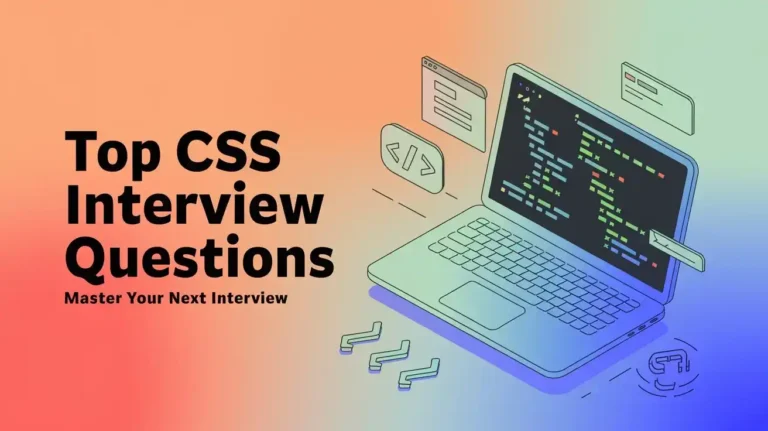Are you ready to ace your next CSS interview? 🚀 Whether you’re a seasoned developer or just starting your journey, mastering CSS interview questions is crucial for landing that dream job. But with so many concepts to cover, where do you even begin?
Don’t worry – we’ve got you covered! In this comprehensive guide, we’ll walk you through the top CSS interview questions and answers that will give you the edge you need. From fundamental concepts to advanced techniques, we’ll explore everything from basic styling to complex layouts and animations. By the time you finish reading, you’ll be armed with the knowledge to tackle any CSS challenge that comes your way.
So, buckle up as we dive into six essential areas: fundamental CSS concepts, advanced techniques, best practices and optimization, browser compatibility and debugging, modern CSS features, and practical scenarios. Let’s transform your CSS skills and boost your confidence for that upcoming interview!
📜Table of Contents
Fundamental CSS Interview Questions Concepts📝
A. Selectors and specificity
CSS selectors are patterns used to select and style HTML elements. Understanding selectors and their specificity is crucial for effective styling. Here’s a breakdown of common selectors and their specificity:
- Element selector:
p(specificity: 1) - Class selector:
.class-name(specificity: 10) - ID selector:
#id-name(specificity: 100) - Attribute selector:
[attribute="value"](specificity: 10) - Pseudo-class selector:
:hover(specificity: 10)
| Selector Type | Example | Specificity |
|---|---|---|
| Element | p | 1 |
| Class | .class-name | 10 |
| ID | #id-name | 100 |
| Attribute | [type="text"] | 10 |
| Pseudo-class | :hover | 10 |
B. Flexbox and Grid layouts
Flexbox and Grid are powerful layout systems in CSS that offer flexible and efficient ways to structure web content.
➤Flexbox
- One-dimensional layout system
- Ideal for distributing space along a single axis
- Key properties:
display: flex,flex-direction,justify-content,align-items
➤Grid
- Two-dimensional layout system
- Perfect for complex, multi-column layouts
- Key properties:
display: grid,grid-template-columns,grid-template-rows,grid-gap
C. Positioning elements
CSS offers various positioning techniques to control the layout of elements:
- Static (default)
- Relative
- Absolute
- Fixed
- Sticky
Each positioning method has its use cases and affects how elements interact with each other in the document flow.
D. Box model explained
The CSS box model is fundamental to understanding how elements are sized and spaced. It consists of:
- Content: The actual content of the element
- Padding: Space between the content and the border
- Border: A line surrounding the padding
- Margin: Space outside the border
| Box Model Component | Description |
|---|---|
| Content | Element’s actual content |
| Padding | Space inside the border |
| Border | Line around the padding |
| Margin | Space outside the border |
Understanding these fundamental CSS concepts is crucial for any web developer. They form the foundation for more advanced techniques and are frequently asked about in CSS interviews. Now that we’ve covered these basics, let’s move on to explore some advanced CSS techniques.
Advanced CSS Techniques🚀
➤CSS Variables and Custom Properties
CSS variables, also known as custom properties, allow developers to define reusable values throughout their stylesheets. This powerful feature enhances code maintainability and flexibility.
:root {
--primary-color: #3498db;
--font-size: 16px;
}
.button {
background-color: var(--primary-color);
font-size: var(--font-size);
}
➤CSS Animations and Transitions
CSS animations and transitions bring life to web pages, creating engaging user experiences. Here’s a comparison of the two:
| Feature | Animations | Transitions |
|---|---|---|
| Trigger | Automatically or by class changes | Property changes |
| Control | Keyframes | Start and end states |
| Complexity | More complex, multi-step | Simple, two-state |
| Use case | Continuous or complex movements | Smooth state changes |
➤Responsive Design Principles
Responsive design ensures websites adapt to various screen sizes. Key principles include:
- Fluid grids
- Flexible images
- Media queries
- Mobile-first approach
➤CSS Frameworks and Their Usage
CSS frameworks provide pre-built components and layouts, speeding up development. Popular options include:
- Bootstrap
- Tailwind CSS
- Foundation
- Bulma
Each framework has its strengths, so choose based on project requirements and personal preference.
➤CSS Preprocessors (SASS, LESS)
Preprocessors extend CSS capabilities, offering features like variables, nesting, and mixins. SASS and LESS are two widely used preprocessors:
- SASS: Uses .scss or .sass file extension
- LESS: Uses .less file extension
Both improve code organization and reduce repetition in stylesheets.
Now that we’ve covered advanced CSS techniques, let’s explore best practices and optimization strategies to enhance your CSS skills further.

CSS Best Practices and Optimization📈
As we delve deeper into CSS, it’s crucial to understand how to write efficient and maintainable code. Let’s explore some key best practices and optimization techniques that can elevate your CSS skills.
A. Performance optimization techniques
Optimizing CSS performance is essential for creating fast-loading websites. Here are some techniques to improve your CSS efficiency:
- Minification
- Combining files
- Using CSS sprites
- Leveraging browser caching
- Employing critical CSS
| Technique | Description | Impact |
|---|---|---|
| Minification | Removing unnecessary characters | Reduces file size |
| Combining files | Merging multiple CSS files | Reduces HTTP requests |
| CSS sprites | Combining multiple images into one | Improves load time |
| Browser caching | Storing CSS files locally | Faster subsequent page loads |
| Critical CSS | Inline essential styles | Improves initial render time |
B. CSS naming conventions
Adopting a consistent naming convention can significantly improve code readability and maintainability. Popular naming conventions include:
- BEM (Block Element Modifier)
- SMACSS (Scalable and Modular Architecture for CSS)
- OOCSS (Object-Oriented CSS)
C. Avoiding common pitfalls
To write better CSS, be aware of these common mistakes:
- Overuse of !important
- Excessive nesting of selectors
- Using overly specific selectors
- Redundant code
- Ignoring browser prefixes
D. Writing efficient CSS
Efficiency in CSS goes beyond performance optimization. Here are some tips for writing clean and efficient CSS:
- Use shorthand properties
- Organize your code logically
- Utilize CSS variables for consistency
- Implement a CSS reset or normalize
- Avoid inline styles when possible
By implementing these best practices and optimization techniques, you’ll not only improve your website’s performance but also create more maintainable and scalable CSS code. Next, we’ll explore how to handle browser compatibility issues and debug CSS effectively.

Browser Compatibility and Debugging🌐
➤Cross-browser compatibility issues
Cross-browser compatibility remains a significant challenge for web developers. Different browsers interpret CSS rules differently, leading to inconsistent rendering across platforms. Here are some common issues and solutions:
- Box model discrepancies
- Font rendering variations
- CSS property support differences
To address these challenges, developers often employ the following strategies:
- Feature detection using JavaScript libraries like Modernizr
- Progressive enhancement
- Fallback styles for older browsers
➤Using developer tools effectively
Browser developer tools are invaluable for CSS debugging and optimization. Here’s a quick guide to using them effectively:
| Tool | Purpose | Key Features |
|---|---|---|
| Element Inspector | Examine and modify DOM | Live CSS editing |
| Styles Panel | View applied styles | Computed styles view |
| Network Tab | Analyze resource loading | CSS file load times |
| Console | JavaScript debugging | CSS-related warnings |
➤Debugging CSS in different browsers
When debugging CSS across browsers, follow these best practices:
- Use browser-specific prefixes for experimental properties
- Test on multiple browsers and devices
- Utilize online tools like BrowserStack or Sauce Labs for comprehensive testing
- Keep an eye on browser update changelogs for CSS-related updates
➤CSS reset and normalization
CSS reset and normalization techniques help create a consistent baseline across browsers:
- CSS Reset: Strips default styles, providing a clean slate
- Normalize.css: Preserves useful defaults while correcting common bugs
By implementing these techniques, developers can ensure a more consistent user experience across different browsers and devices. Remember to regularly update your reset or normalization files to account for new browser versions and CSS features.
Now that we’ve covered browser compatibility and debugging, let’s explore some modern CSS features that can enhance your web development toolkit.
Modern CSS Features🆕
As we delve into the world of modern CSS, we’ll explore exciting new features that have revolutionized web design and development. These advancements have made CSS more powerful and flexible than ever before.
➤New CSS selectors and pseudo-classes
CSS selectors and pseudo-classes have expanded significantly, offering developers more precise control over element targeting. Here are some notable additions:
:is()and:where(): Simplify complex selector lists:has(): Select parent elements based on their children:not(): Negate other selectors with improved specificity
➤CSS-in-JS approaches
CSS-in-JS has gained popularity, allowing developers to write CSS directly within JavaScript. This approach offers several benefits:
| Benefit | Description |
|---|---|
| Scoping | Styles are automatically scoped to components |
| Dynamic styling | Easily create dynamic styles based on props or state |
| Code splitting | CSS is only loaded when the corresponding component is used |
Popular CSS-in-JS libraries include styled-components and Emotion.
➤CSS Modules and scoping
CSS Modules provide a way to write modular and reusable CSS by automatically scoping class names. This technique:
- Eliminates global namespace conflicts
- Improves maintainability
- Enhances collaboration in large projects
➤CSS Grid in-depth
CSS Grid has transformed layout design, offering a powerful two-dimensional system for creating complex layouts. Key features include:
- Fractional units (fr) for flexible sizing
- Implicit and explicit grid creation
- Grid template areas for named grid spaces
- Auto-placement algorithms for dynamic content
With these modern CSS features, developers can create more efficient, maintainable, and visually appealing websites. Next, we’ll explore practical CSS scenarios to apply these concepts in real-world situations.
Practical CSS Scenarios📌
Now that we’ve covered various CSS concepts and techniques, let’s dive into some practical scenarios where you can apply your CSS skills.
A. Crafting custom buttons and CTAs
Custom buttons and Call-to-Action (CTA) elements are essential for creating engaging user interfaces. Here’s a simple example of a custom button using CSS:
.custom-button {
padding: 10px 20px;
background-color: #3498db;
color: white;
border: none;
border-radius: 5px;
transition: background-color 0.3s ease;
}
.custom-button:hover {
background-color: #2980b9;
}
B. Building image galleries
CSS grid and flexbox are powerful tools for creating responsive image galleries. Here’s a basic example using CSS grid:
.gallery {
display: grid;
grid-template-columns: repeat(auto-fit, minmax(200px, 1fr));
gap: 10px;
}
.gallery img {
width: 100%;
height: auto;
object-fit: cover;
}
C. Designing forms with CSS
Styling forms can greatly improve user experience. Here’s a table showcasing some common form elements and their CSS properties:
| Element | CSS Properties |
|---|---|
| Input fields | padding, border, border-radius |
| Labels | font-weight, margin-bottom |
| Submit button | background-color, color, hover effects |
| Fieldset | border, margin, padding |
D. Implementing card layouts
Card layouts are popular for displaying content in a structured and visually appealing manner. Here’s a basic card structure:
.card {
background-color: #fff;
border-radius: 8px;
box-shadow: 0 2px 4px rgba(0, 0, 0, 0.1);
padding: 20px;
margin-bottom: 20px;
}
.card-title {
font-size: 18px;
margin-bottom: 10px;
}
.card-content {
font-size: 14px;
}
E. Creating responsive navigation menus
Responsive navigation menus are crucial for mobile-friendly websites. Here’s a list of techniques for creating responsive menus:
- Use media queries to adjust layout for different screen sizes
- Implement a hamburger menu for mobile devices
- Utilize CSS transitions for smooth open/close animations
- Consider using flexbox for easy alignment and spacing
Next, we’ll explore how these practical scenarios can be applied in real-world projects and discuss common challenges you might face during implementation.
🎯Conclusion
Mastering CSS is crucial for any web developer aiming to create stunning, responsive websites. From fundamental concepts to advanced techniques, CSS offers a wide array of tools to enhance the visual appeal and functionality of web pages. By understanding best practices, optimization techniques, and browser compatibility issues, developers can ensure their CSS code is efficient and works seamlessly across different platforms.
As the web development landscape continues to evolve, staying up-to-date with modern CSS features is essential. By honing your skills in CSS and practicing with real-world scenarios, you’ll be well-prepared to tackle any CSS-related challenge in your next interview or project. Remember, the key to success lies in continuous learning and practical application of your CSS knowledge.
You can visit our blog website Tutorial Temple for more related information.
